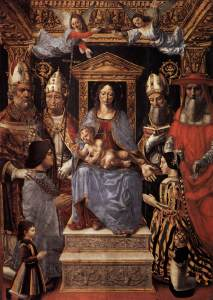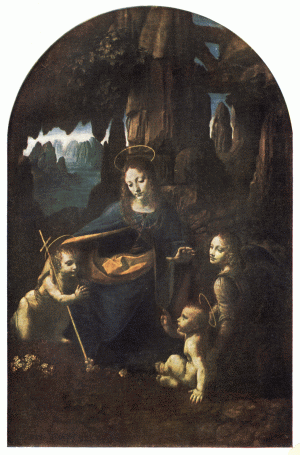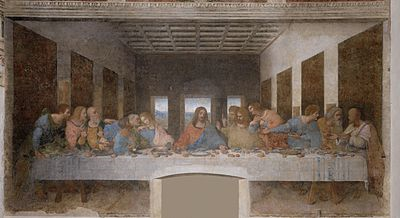Introduction
Ludovico il Moro and his family Kneeling before the Virgin is an altarpiece painting done by Leonardo Da Vinci who was a famous archetype of the renaissance period (1400-1500). He was an Italian mathematician, scientist, inventor, engineer, anatomist, musician, botanist, architect and painter. The altarpiece was a religious painting work that symbolized the Virgin and child with four physicians of the temple and the entire family of Ludovico il Moro which comprised of Ludovico, his wife and daughter. Ludovico ordered a painting in 1494 for the Sant’Ambrogio and Nemus’ church in Milan. The image portrays the duke of Milan who was Ludivico, his wife Bearrice d’Este and their kids, Francesco, Massimiliano and Ercole. This is clearly observed in the diagram below which is the painting itself. This painting was one of the most challenging artistic works of the late fourteenth century in Lombardy.
The image shows a cooperate attempt to encompass new notions motivated by Leonardo Da Vinci in an ornamental composition that remains instilled with the late Gothic spirit. In fact, the painting was an outstanding interest in the arcade of the donors’ portraits. The most excellent part of it is the description of Beatrice d’Este whereby Leornado who was its novelist described her as “beautiful and dark, and inventive in designing new clothes.” The ultimate aim of this context is to examine the painting’s artistic style used, period, uniqueness and what it presented. It also examines the comparison of Ludovico il Moro and his family Kneeling before the Virgin and other paintings of the same Milanese period. The following diagram shows the Ludovico il Moro and his family Kneeling before the Virgin painting of 1494.

Description of the Painting
In 1481, Ludovico il Moro presupposed in the name of his nephew, Gian Galaezzo, the Duchy of Milan’s regency. He was one of the highly incredible princes in the tyrants age of genius which means that he was magnificent, ambitious, clever and cruel. A correspondence which had its copy forming part of the commemorated “Codex Atlanticus”, which was in the Milan’s Ambrosian Library. The library contains several terms that were used by Leonardo when offering his services to the prohibited lord. This painting was oil on panel diagram that clearly illustrates everything that Leonardo intended to pass forth. This means that the image is self explanatory in the sense that it clearly displays the Virgin carrying the child while the duke, Ludovico il Moro kneels before her with his wife Beatrice, and children, Francesco, Massimiliano and Ercole. Leonardo was thirty when he painted this image.
Therefore, it is clear that he was young, handsome and accomplished person who had an enthusiastic mind for the innovation of fables. His colleague, for instance Bendello, was a good storyteller who associated the charms of his dialogue. This shows that indeed Leonardo was very smart during the Renaissance period where he displayed his artistic and architectural skills excellently.
Leonard’s Paintings and other Works
Apart from being a painter and architecture, Leonardo was also a musician who was very good in writing scripts and improvising song versus. He wrote the versus while accompanying himself on a lute that he made through his own invention. The lute was shaped like a bucranium producing fabulous sonorousness. Leonardo was much disproportionate in his invention and production of fetes, amusements, ballets and interludes of which the renaissance era loved very much. During the time through which Louis XII’s admission into Milan, a mechanical lion traversed the banquet hall and stopped him before he took a shower of lilies. The mechanical machine that did that had been modeled by Leonardo who entered into the service of Ludovico il Moro towards the end of 1482.
Comparison of Ludovico il Moro and his Family Kneeling before the Virgin” with “Woman with a Marten”
One of the earliest Milanese painting works was the pleasant “Woman with a Marten”, which was thought to be the depiction of Cecilia Gallerani who was Ludovico’s mistress. The painting is still kept at Cracow in the library of Count Czartorisky. However, the work has greatly been affected by restorations but it remains the first real modern work of its kind. It is unique in the sense that it constituted of feminine elegance, loveliness of moral personality and devious of analysis, and not sheer likeliness of features. The attractive profile of “Beatrice d’Este” at the Amrosian and the ostensible “Lucrezia Criveli” which was also referred to as “La Belle Ferroniere” of the Louvre was very different from Leonardo.
Woman with a Marten has several similarities with Ludovico il Moro and his family Kneeling before the Virgin. To begin with, Leonardo Da Vinci who showed his creativeness through usage of different schemes did both paintings. Secondly, both paintings were oil paintings made on panel. This feature is considered to be comparatively new and beautiful form of art of all the picturesque art schemes in the world. Leonardo used the oil painting scheme to acquire a mythological and decorative viewpoint to art. However, his oil painting was quite different from the common decorative forms of oil painting in the sense that both images had distinct means of propagating their art with the Renaissance.
Moreover, both paintings were done in Milan with Leonardo focusing on duke Ludovico’s family. Woman with a Marten was a painting about a young beautiful woman, Cecilia Gallerani who was a Ludovico’s mistress. The image was intended to portray the attractiveness of women and the role they play in such significant families like duke’s family. Ludovico il Moro and his family Kneeling before the Virgin on the other hand was a painting that also focused on duke Ludovico il Moro’s family where the image shows il Moro kneeling before the Virgin who had a child in her arms. The only difference between the two paintings by Leonardo is the fact that “Woman with a Marten” had a single person who was Cecilia Gallerani, the mistress to Ludovico while Ludovico il Moro and his family Kneeling before the Virgin had the entire family of Ludovico il Moro.
The other major difference between the two paintings is the fact that Ludovico il Moro and his family Kneeling before the Virgin has a religious theme whereby Leonardo attempted to pass important message to the world. A whole duke with his entire family kneeling before the holy Virgin carrying whom we believe was baby Jesus showed that even wealth cannot be compared to the servant of God or the power of Christ. He simply meant that all people must bow or praise God in their lifetime no matter what. “Woman with a Marten” on the other hand was all about woman empowerment. In other words, the painting portrayed the strength and attractiveness of women to men. Therefore, the themes of the two paintings was very different.
Comparison of “Ludovico il Moro and his Family Kneeling before the Virgin” and “Virgin of the Rocks”
Still in Milan in early years of his voyage, he accomplished his first picture, “Virgin of the Rocks”. Other than the copies, there are two of these paintings existing today although they slightly differ in their details. One of them is at Louvre while the other one is at the National Gallery. The genuineness and realism of the two pictures brought endless interventions but the fact is that both of them are original. The first difference between Virgin of the Rocks and Ludovico il Moro and his Family Kneeling before the Virgin is the fact that the first one had two original copies which had slightly different details meaning slight distinction on theme while the second one was just one.
The first of the two Virgin of the Rocks paintings was that of Louvre, the implementation whereby it still displayed something of the somewhat dehydrated technique of Verrocchio’s studio. The other one which came later was repeated the design of the convent of San Francesco who was believed to be the son of Ludovico. This painting had the Ambrogio da Predis side tinted with angels playing on musical tools. The musical instruments are still with the original painting at the National Gallery.
Another difference between this painting and “Ludovico il Moro and his Family Kneeling before the Virgin” comes out clearly in the sense that the picture had some unique decorations of angels playing musical tools while Ludovico il Moro and his Family Kneeling before the Virgin never had such decorations. However, Leonardo was very brave and full of ideas since there are some ideas on the second picture that did not exist on the first one. For example, Ludovico il Moro and his Family Kneeling before the Virgin used an oil on panel scheme while Ambrogio da Predis used the canvas system.
Comparison of “Ludovico il Moro and his Family Kneeling before the Virgin” and The “Madonna of the Carnation”
Madonna of the Carnation by the same artist is an oil painting that was completed between the years 1478 -1480. The dimensions of the Madonna of the Carnation are roughly 62 cm × 47.5 cm (24 in × 18.7 in). the painting is an illustration of the virgin Mary with the baby Jesus on her hands. In her left arm, the virgin Mary embraces red carnation. Some people have deduced that this is a healing symbol.
At one point, Madonna of the Carnation is compared to the artistic works of Andrea del Verrocchio. It has however been accepted as the work of Leonardo da Vinci in the recent times. The Madonna of the Carnation work can be viewed at the Alte Pinakothek porch in Munich, Germany. This painting is similar to the Ludovico il Moro and his Family Kneeling before the Virginbecause both have a painting of the virgin Mary. In essence the two paintings have the symbol of the virgin Mary holding the baby Jesus. The paintings are magnificent and probably express a common goal. The goal being the significance of virgin Mary and the birth of Jesus Christ to the virgin.
Leonardo was also able to portray his architectural skills when he depicted the angel kneeling behind the Infant Jesus whose approach was much different from that of the Paris angel; it was one of the most perfect creativity that was portrayed by him. The diagram below clearly shows it.

One of the similarities seen between Ludovico il Moro and his Family Kneeling before the Virgin and Virgin of the Rocks is that both of them have a religious theme in the sense that in both, Jesus Christ is depicted as King of Kings. This is because Ludovico was a very wealthy duke whom nobody could expect to worship or kneel before the Virgin Mary and the baby Jesus but he did exactly that. On the second painting, the angel is also seen kneeling before Jesus showing sign of respect and obedience to his King. Therefore, both of them have a religious aspect with same theme. Moreover, in both cases, the duke, Ludovico and the angle respectively are seen kneeling before Jesus. The kneeling aspect depicted in both images is also another similarity between the two paintings. Besides, the fact that both paintings have the image of the Virgin also shows a similarity between the two.
Comparison of Ludovico il Moro and his Family Kneeling before the Virgin with the “Last Supper”
The last supper was another superb work by Leonardo at Milan which he painted in the cafeteria of the Dominican convent of Sta Maria delle Grazie. This work was so different from the other earlier works in the sense that most of the initial works including Ludovico il Moro and his Family Kneeling before the Virgin employed the oil scheme which was either on a panel or wood. However, the Last Supper was a fresco painting which appeared to be too swift and immediate process that made him ruin it somehow since he painted it on the wall. Mugginess soon intensified and soaked the entire work ruining it completely in the sense that in mid 16th century, it was irreparable. However, similar work was done by Vandalism in 1652 who went to the same wall and could tress some remains of the painting. Vandalism was able to see the feet of Christ and two Apostles. He then went forth to recreate it but the stable refectory of the painting was done by Daubers Wrought and Bonaparte in 1797.
In general, the original Last Supper painting done by Leonardo was all about Jesus Christ sharing his last meal on earth with his 12 disciples where also told them how he was going to die and the things that were going to take place. For example, he told them that he was going to be betrayed by one of them and that happened later. He also told Peter that the cock will not craw three times before he deny him. The image portrayed Jesus sitting in the middle of the 12 Apostles talking to them and distributing wine and bread to them. This is clear observed in the diagram below.

There are a number of similarities between the Last Supper and Ludovico il Moro and his Family Kneeling before the Virgin paintings. First, both paintings have a religious theme in the sense that both of them contain Jesus Christ who is believed to be son of God. Secondly, Jesus is depicted to be superior and king in both cases in the sense that he is obeyed, respected and worshiped. Besides, both paintings show that Jesus has followers who respect, obey and worship hi, in the sense that the last Supper had his disciples with him showing that they were right with him in gospel. The Ludovico il Moro and his Family Kneeling before the Virgin also shows that Ludovico and his family were followers of Christ in the sense that they worshipped him despite him being a child in his mother’s arms.
Bibliography
Baxandall, Michael. Painting and Experience in Fifteenth Century Italy. New York, Doubleday, (1974). pp. 49–56. Web.
Baxandall, Michael. Painting and Experience in Fifteenth Century Italy. Oxford: Oxford University Press, 1974. Web.
Capra, Fritjof. The Science of Leonardo; Inside the Mind of the Genius of the Renaissance. New York, Doubleday, 2007. Web.
Cremante, Simona. Leonardo da Vinci: Artist, Scientist, Inventor. London: Giunti. 2005. Web.
Hartt, Frederich. A History of Italian Renaissance Art. Oxford: Oxford University Press, 1970. pp. 127–333. Web.
Lupia, John N. “The Secret Revealed: How to Look at Italian Renaissance Painting”. Medieval and Renaissance Times, 1, no. 2 (1994): 6–17. Web.
Mason, Stephen F. A History of the Sciences. New York, NY: Collier Books, (1962): p. 550. Web.
Vezzosi, Alessandro. Leonardo da Vinci: Renaissance Man. (English translation).Thames & Hudson Ltd, London, 1997. Web.